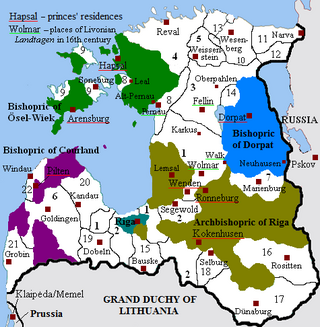
Livonia or in earlier records Livland, is a historical region on the eastern shores of the Baltic Sea. It is named after the Livonians, who lived on the shores of present-day Latvia.
The Northern Crusades or Baltic Crusades were colonization and Christianization campaigns undertaken by Catholic Christian military orders and kingdoms, primarily against the pagan Baltic, Finnic and West Slavic peoples around the southern and eastern shores of the Baltic Sea, and also against Orthodox Christian Slavs.

The Teutonic Order is a Catholic religious institution founded as a military society c. 1190 in Acre, Kingdom of Jerusalem. The Order of Brothers of the German House of Saint Mary in Jerusalem was formed to aid Christians on their pilgrimages to the Holy Land and to establish hospitals. Its members have commonly been known as the Teutonic Knights, having historically served as a crusading military order for supporting Catholic rule in the Holy Land and the forced conversion to Catholicism in the Baltics during the Middle Ages, as well as providing military protection for Catholics in Eastern Europe.

Jogaila, later Władysław II Jagiełło, was Grand Duke of Lithuania (1377–1434) and then King of Poland (1386–1434), first alongside his wife Jadwiga until 1399, and then sole ruler of Poland. Born a pagan, he converted to Catholicism in 1386 and was baptized as Ladislaus in Kraków, married the young Queen Jadwiga, and was crowned King of Poland as Władysław II Jagiełło. In 1387, he converted Lithuania to Catholicism. His own reign in Poland started in 1399, upon the death of Queen Jadwiga, lasted a further thirty-five years, and laid the foundation for the centuries-long Polish–Lithuanian union. He was a member of the Jagiellonian dynasty in Poland that bears his name and was previously also known as the Gediminid dynasty in the Grand Duchy of Lithuania. The dynasty ruled both states until 1572, and became one of the most influential dynasties in late medieval and early modern Europe.
The Livonian Brothers of the Sword was a Catholic military order established in 1202 during the Livonian Crusade by Albert, the third bishop of Riga. Pope Innocent III sanctioned the establishment in 1204 for the second time. The membership of the crusading order comprised warrior monks, mostly from northern Germany, who fought Baltic and Finnic polytheists in the area of modern-day Estonia, Latvia and Lithuania. Alternative names of the Order include Christ Knights, Swordbrothers, Sword Brethren, Order of the Brothers of the Sword, and The Militia of Christ of Livonia. The seal reads: +MAGISTRI ETFRM MILICIE CRI (Christi) DE LIVONIA.
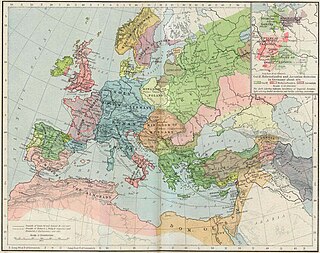
The High Middle Ages, or high medieval period, was the period of European history that lasted from AD 1000 to 1300. The High Middle Ages were preceded by the Early Middle Ages and were followed by the Late Middle Ages, which ended around AD 1500.

Total War is a series of strategy games developed by British developer Creative Assembly for personal computers. They combine turn-based strategy and resource management with real-time tactical control of battles. Rather uniquely for real-time strategy games, flanking manoeuvers and formations factor heavily into gameplay. The first of the series, Shogun: Total War, was released in June 2000. The most recent major game released was Total War: Pharaoh on October 11, 2023. As of April 2021, the series had sold over 36 million copies.

The State of the Teutonic Order was a medieval Crusader state, located in Central Europe along the southeastern shore of the Baltic Sea. It was formed by the knights of the Teutonic Order during the 13th century Northern Crusades in the region of Prussia. The Livonian Brothers of the Sword merged in 1237 with the Teutonic Order of Prussia and became known as its branch, the Livonian Order, while their state,Terra Mariana, became a part of the State of the Teutonic Order. At its greatest territorial extent, in the early 15th century, it encompassed Chełmno Land, Courland, Gotland, Livonia, Neumark, Pomerelia, Prussia and Samogitia, i.e. territories nowadays located in Estonia, Latvia, Lithuania, Germany, Poland, Russia, and Sweden.
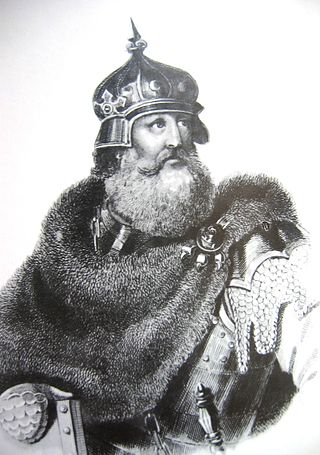
Kęstutis was the Grand Duke of Lithuania. He was the Duke of Trakai and governed the Grand Duchy of Lithuania, 1342–1382, together with his brother Algirdas, and with his nephew Jogaila.

The Polish–Lithuanian–Teutonic War, also known as the Great War, occurred between 1409 and 1411 between the Teutonic Knights and the allied Kingdom of Poland and Grand Duchy of Lithuania. Inspired by the local Samogitian uprising, the war began with a Teutonic invasion of Poland in August 1409. As neither side was ready for a full-scale war, Wenceslaus IV of Bohemia brokered a nine-month truce.

Medieval II: Total War is a strategy video game developed by the since-disbanded Australian branch of The Creative Assembly and published by Sega. It was released for Microsoft Windows on 10 November 2006. Feral Interactive published versions of the game for MacOS and Linux on 14 January 2016. It is the sequel to 2002's Medieval: Total War and the fourth title in the Total War series.

The Prussian Crusade was a series of 13th-century campaigns of Roman Catholic crusaders, primarily led by the Teutonic Knights, to Christianize under duress the pagan Old Prussians. Invited after earlier unsuccessful expeditions against the Prussians by Christian Polish kings, the Teutonic Knights began campaigning against the Prussians, Lithuanians and Samogitians in 1230. By the end of the century, having quelled several Prussian uprisings, the Knights had established control over Prussia and administered the conquered Prussians through their monastic state, eventually erasing the Prussian language, culture and pre-Christian religion by a combination of physical and ideological force. Some Prussians took refuge in neighboring Lithuania.
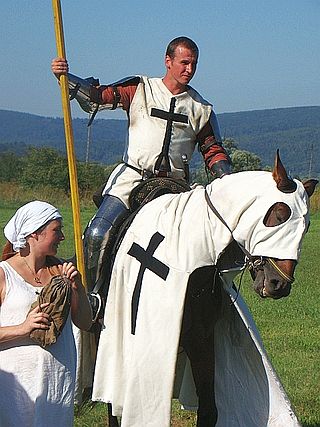
Teutonic Knights, a crusading military order for the forced conversion to Catholicism in the Holy Land and the Baltics during the Middle Ages, are often depicted in popular culture.

The Lithuanian Civil War of 1381–1384 was the first struggle for power between the cousins Jogaila, Grand Duke of Lithuania and later King of Poland, and Vytautas the Great. It began after Jogaila signed the Treaty of Dovydiškės with the Teutonic Knights which was aimed against his uncle Kęstutis, father of Vytautas. Kęstutis briefly seized power in the Grand Duchy, but was betrayed by adherents of Jogaila primarily from Vilnius. During negotiations for a truce Kęstutis and Vytautas were arrested and transported to the Kreva Castle. Kęstutis died there a week later but Vytautas managed to escape and then sought an alliance with the Teutonic Knights. Subsequently their joint forces raided Lithuanian lands. Eventually the cousins were reconciled as Jogaila needed internal stability in anticipation of negotiations with the Grand Duchy of Moscow and the Kingdom of Poland regarding the possible Christianization of Lithuania. The war did not settle the power struggle; it continued during the next Lithuanian Civil War (1389–1392) which was resolved by the signing of the Ostrów Agreement. After more than ten years of struggle, Vytautas finally became the Grand Duke of Lithuania and ruled the country for thirty-eight years.
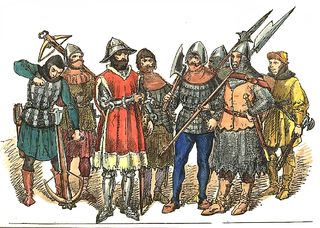
The Thirteen Years' War, also called the War of the Cities, was a conflict fought in 1454–1466 between the Crown of the Kingdom of Poland and the Teutonic Order.

The Battle of Grunwald, Battle of Žalgiris, or First Battle of Tannenberg, was fought on 15 July 1410 during the Polish–Lithuanian–Teutonic War. The alliance of the Crown of the Kingdom of Poland and the Grand Duchy of Lithuania, led respectively by King Władysław II Jagiełło (Jogaila), and Grand Duke Vytautas, decisively defeated the German Teutonic Order, led by Grand Master Ulrich von Jungingen. Most of the Teutonic Order's leadership were killed or taken prisoner.

Terra Mariana was the official name for Medieval Livonia or Old Livonia. It was formed in the aftermath of the Livonian Crusade, and its territories were composed of present-day Estonia and Latvia. It was established on 2 February 1207, as a principality of the Holy Roman Empire, and lost this status in 1215 when Pope Innocent III proclaimed it as directly subject to the Holy See.

The siege of Medvėgalis was a brief siege of Medvėgalis, a Lithuanian fortress in Samogitia, in February 1329 by the Teutonic Order reinforced by many guest crusaders, including King John of Bohemia. The 18,000-strong Teutonic army captured four Lithuanian fortresses and besieged Medvėgalis. The fortress surrendered and as many as 6,000 locals were baptized in the Catholic rite. The campaign, which lasted a little more than a week, was cut short by a Polish attack on Prussia in the Polish–Teutonic War (1326–32). As soon as the Teutonic army returned to Prussia the Lithuanians returned to their pagan practices and beliefs.
The Raid on Brandenburg was a Polish–Lithuanian raid on the Margraviate of Brandenburg in February–March 1326. With papal approval and encouragement, King Władysław I of Poland allied with Gediminas of Lithuania and organized the raid against Louis V of Germany. Pope John XXII opposed Louis' ambitions to become the Holy Roman Emperor, King Władysław regarded Neumark as Polish territory, while Lithuanians sought loot. The Teutonic Knights, under papal pressure, observed its peace treaties with Poland and Lithuania and did not interfere. The Polish–Lithuanian army raided Brandenburg for a month, reaching Frankfurt and Berlin, and took 6,000 prisoners.

The Lithuanian Crusade was a series of campaigns by the Teutonic Order and the Livonian Order under the pretext of forcibly Christianizing the pagan Grand Duchy of Lithuania. The Livonian Order occupied Riga in 1202 and in the 1230s they settled in Chełmno Land, a fief of Poland. They first conquered other neighboring Baltic tribes—Curonians, Semigallians, Latgalians, Selonians, and Old Prussians—in the Livonian Crusade and Prussian Crusade.















